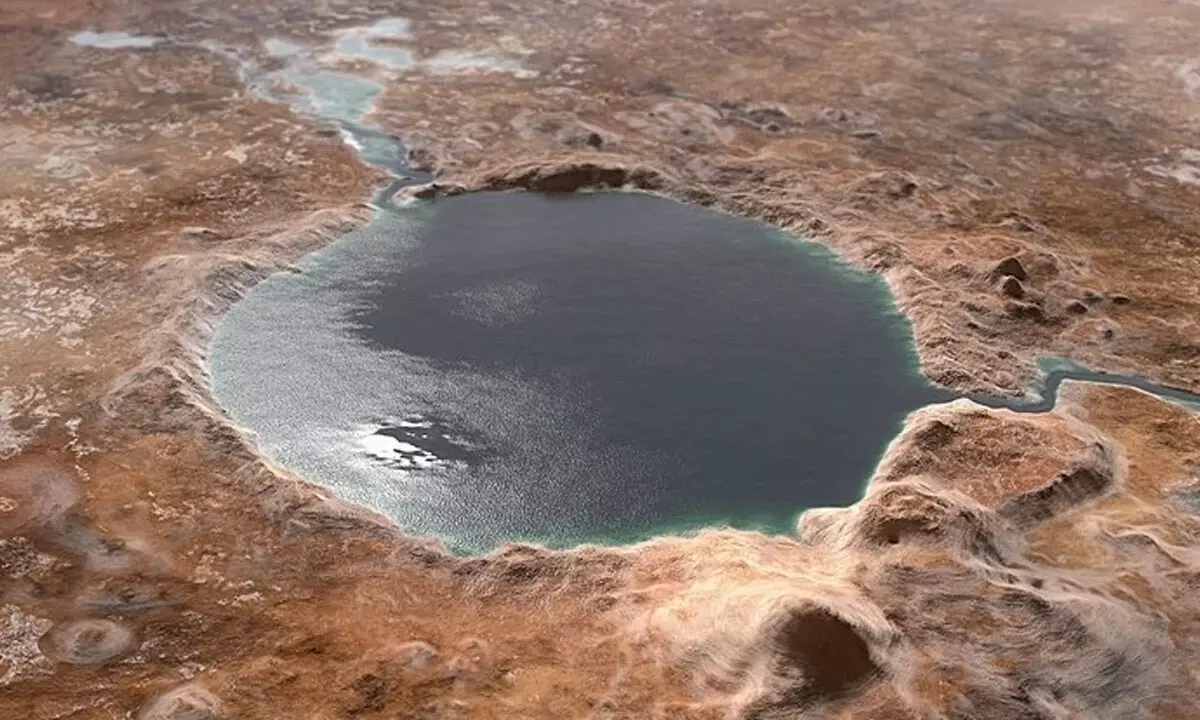Researchers Found New Insights Of Mars Hidden Past

Artist’s impression of what Jezero Crater may once have looked like billions of years ago. (NASA/JPL-Caltech)
- The first directly retrieved samples of Martian rock and soil to be examined in a lab on Earth, and it is anticipated that they will provide some tantalising information about the red planet's past.
- Based on a recent study by a research team led by the University of California at Los Angeles (UCLA) and the University of Oslo, perseverance ground-penetrating radar spotted the oddly inclined rock layers beneath the crater.
The Perseverance rover touched down at Mars' Jezero Crater on February 18, 2021. Similar to its cousin, the Curiosity rover, Perseverance has since been exploring the area in search of signs of ancient and potentially even contemporary life.
This includes collecting samples for a future ESA/NASA sample-return mission that will store them in a cache and recover them. These will be the first directly retrieved samples of Martian rock and soil to be examined in a lab on Earth, and it is anticipated that they will provide some tantalising information about the red planet's past.
But given that the Perseverance rover is already returning some unexpected data to Earth, it seems we don't need to wait for the sample-return mission.
Based on a recent study by a research team led by the University of California at Los Angeles (UCLA) and the University of Oslo, perseverance ground-penetrating radar spotted the oddly inclined rock layers beneath the crater. These odd parts might be sedimentary deposits from an underground lake or they might be the product of lava flows that slowly cooled.
Svein-Erik Hamran, a professor of autonomous systems and sensor technologies at the University of Oslo (UiO), served as the team's leader. He is also the principal investigator for the Radar Imager for Mars Subsurface eXperiment (RIMFAX), which is being carried out by the Perseverance rover.
Furthermore, researchers from the University of Oregon, the University of California, the Planetary Science Institute (PSI), Vestfonna Geophysical, the Centro de Astrobiologa, the Norwegian Polar Institute, NASA's Jet Propulsion Laboratory, and numerous other universities joined him.
Perseverance, which has been investigating the significant rock and clay mineral deposits deposited near its western side, where water formerly poured into the crater, chose this area specifically as the landing site.
Similar to Curiosity, the goal of this mission is to gather more information about the times when flowing water was present on Mars' surface so that scientists can better understand how (and when) Mars changed into the chilly, arid world it is today.
The Radar Imager for Mars Subsurface eXperiment has carried out the first rover-mounted ground-penetrating radar survey of the Martian subsurface, provided the initial data that the researchers studied, as they note in their report. This study gave continuous data on the electromagnetic characteristics of the crater's bedrock structure to depths of 15 metres below the surface as the rover made its initial 3-km walk across the Jezero Crater.
Layered sequences that dip downhill at angles up to 15 degrees were visible in the ensuing radar images. The research team discovered after examining the data that layered rock was widespread in the area covered by Perseverance. Even more puzzling, they discovered that the highly reflecting rock strata in the inclined sections tilted in different directions.
The most likely explanation for the angled layers they saw leads to an igneous origin, in which rock layers were produced over time by the passage of lava underneath before they cooled and solidified.
The strata may, however, be sedimentary, which is a process that frequently occurs in watery areas on Earth. When the samples acquired by Perseverance are sent back to Earth for analysis, the information gathered by RIMFAX will be extremely valuable. The necessary context for defining the samples will be provided by understanding what is below the Jezero Crater and how it developed.
This will help us paint a clearer picture of how, when, how long, and whether or not flowing water existed on Mars' surface. It will also show how and when Mars changed from its current highly arid and cold climate.


















